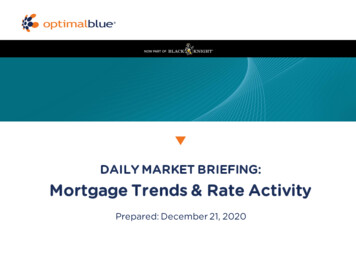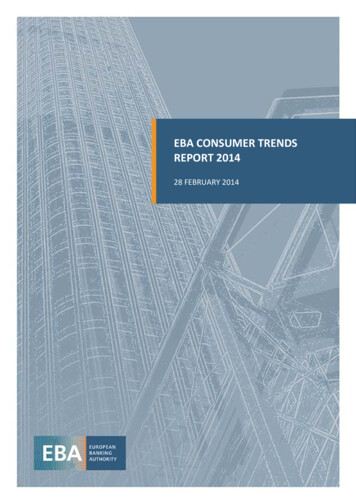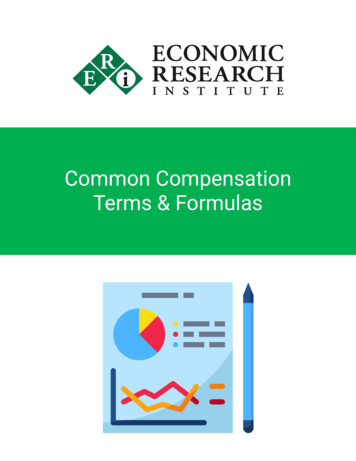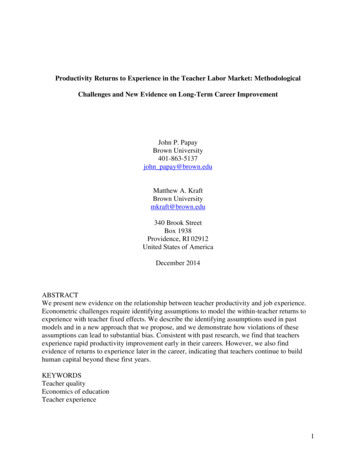
Transcription
Market TrendsQuarter 2 2021COMMERCIAL INSURANCE & RISK MANAGEMENT
OUR GOALBrown & Brown’s MarketTrends allows you to connectquickly to succinct key topicsand notable updates in theinsurance marketplace. Divedeeper on any topic with ourBrown & Brown Team to betterunderstand how these trendsmay impact your business. Wewelcome the conversation.Enjoy.2 Summary3 PropertyDISCOVER4 Casualty5 Executive Liability7 Cyber Liability9 International
2MARKET SUMMARYQ2 2021The outlook for the second quarter of 2021 remains challenging for many insureds.So far, 2021 has delivered devastating winter storms, high-profile cybersecurityattacks, and tightening underwriting standards. Sectors that enjoyed historiccompetitive pricing may now face rate increases, higher deductibles, and morestringent underwriting measures. Companies are advised to take early and thoroughaction to prepare for insurers’ scrutiny. Brown & Brown is here to help.
3PROPERTYQ2 2021Property insurance rates continue to have upward traction, with no sign of levelingoff in the second quarter of 2021. Increased rates, reduced capacity, and coveragereductions are affecting many commercial insurance buyers. Loss-free insureds canexpect to see rate increases of 5% to 15%. Insureds with losses, outstanding riskcontrol recommendations, or those in tougher occupancy classes, such as moltenmetal, PowerGen (coal), habitational, food and manufacturing, etc., can expect 15%rate increases. Insurers continue to address persistent obstacles to profitability, e.g.,deficient interest rates, and continued attritional and catastrophic losses. Insurers arealso passing 10% to 15% increased reinsurance costs to insureds.In an otherwise benign quarter, the mid-February Texas winter storms may exceed 10 billion in property damage losses. Losses from these storms will impact insurancepricing in future quarters.In addition to rate, coverage, and capacity changes, property underwriters havea rejuvenated focus on seeing adequate valuations and risk improvements.If appraisals are not available, providing a supporting methodology is key togaining underwriter support. Additionally, providing current, positive risk controlrecommendation responses helps promote a favorable position.In addition to rate, coverage, andcapacity changes, property underwritershave a rejuvenated focus on seeingadequate valuations and riskimprovements.
4CASUALTYQ2 2021Workers’ compensation rates have remained stable for most industries and in most states.The National Council on Compensation Insurance (NCCI) reports that insurers recordedan 86% combined ratio in 2020, up only slightly from 2019. This line of coverage certainlybenefited from COVID-19 remote workforce mandates, although the full effect of incurred butnot reported claims remains under scrutiny. Prices are beginning to rise in 2021 after years ofrate decreases. The combination of medical cost inflation and an increasingly unhealthy andaging workforce means employers are dealing with escalating per claim costs.The hardening of the liability market continues into 2021. Loss severity continues toaccelerate, driven by a growing anti-business sentiment, aggressive plaintiff’s bar, medicalinflation, and third-party litigation financing. The increase in loss severity, combined withthe economic and legal uncertainty from COVID-19, allows insurers to remain selective.New capital is entering the market, although much of it is opportunistic and looking to takeadvantage of current pricing models.The commercial auto insurance market remains challenged. Although miles driven decreasedwith remote working, loss severity continued to increase. Distracted driving, rate of speed,higher repair costs, and aggressive legal firms continue to push claim costs. Large fleets andcustomers with a poor loss history will likely experience significantly higher rates and reducedinsurer interest.While much of the rate adequacy focus over the last few years has been on auto, premisesdriven exposures are becoming problematic. The recent 70M Georgia Kroger verdict isbeing cited as a potential precedent for a company to be held liable based on negligentsecurity allegations. In addition to pushing rates, insurers are looking to increase deductiblesand retentions while offering more restrictive terms and conditions.The impact of stringent underwriting can be felt the most in the umbrella/excess marketplace,where insurers are reducing capacity and increasing rates. The greatest pain is felt in theprimary 10M of umbrella/excess coverage as the impact of nuclear verdicts has forcedseveral insurers out of the space and has led to higher rates and reduced capacity. Accordingto Advisen, the median cost of a single fatality jumped to over 5.1M in 2019, more thandouble the cost in 2015.The impact of stringent underwritingcan be felt the most in the umbrella/excess marketplace, where insurers arereducing capacity and increasing rates.
5EXECUTIVE LIABILITYQ2 2021Historically, excessive fee litigation was targeted at select large organizations;however, there recently has been an uptick in claims against all sizes of retirementplans. In 2020 alone, there were more than 90 excessive fee lawsuits filed.Insurers are scrutinizing fiduciary exposures unlike what has ever been seen inthe marketplace. Mass/Class action retentions are becoming increasingly common.In response, insurers are looking to reduce capacity on fiduciary renewals. Onecommon theme insurers want to ensure is that the plan sponsor has a detailedprocess in place and documentation of why decisions were made or providerswere selected.In 2020, 250 special purpose acquisition companies (SPACs) completed an initialpublic offering (IPO). Already in 2021, more than 160 have filed IPOs. SPACsare a type of blank check company, meaning it has no specific business planor purpose. It has become a popular vehicle for companies transitioning fromprivately-held to publicly-traded. Due to the dramatic increase in SPAC IPO filingsin the past 18 months, insurers have significantly altered terms for those directorsand officers (D&O) placements. Given the popularity and amount of SPAC IPOs,the market is closely monitoring claims that may arise from this current trend. TheU.S. Securities and Exchange Commission (SEC) is also carefully watching thesecompanies and has issued investor publications and alerts. In addition, the SEChas sent letters to Wall Street banks seeking information on SPAC dealings giventhe recent spike in popularity.With the Biden Administration, there may be new rules and activity emerging in 2021,including the following: The SEC is expected to increase enforcement on misconduct in comparison tothe approach by the Trump Administration. There may be increased employment-related enforcement by the EqualEmployment Opportunity Commission (EEOC). Senator Amy Klobuchar introduced a new bill to reshape the country’santitrust laws. As a result, within certain industries, insurers in the marketplace are managingtheir regulatory exposure on D&O by cutting capacity for regulatory claims.
6In December, the EEOC issued a publication, “What You Should Know AboutCOVID-19 and the ADA, the Rehabilitation Act and Other EEO Laws.” Thepublication provides information about how a COVID-19 vaccination relates tothe legal requirements of the Americans with Disabilities Act (ADA) and other U.S.anti-discrimination laws. The guidance provided by the EEOC points to allowingemployers to mandate vaccinations; however, employers must be prepared toaccommodate employees who may not get vaccinated for medical or religiousreasons and violating any anti-discrimination laws. Companies should seek legalcounsel and document all decisions surrounding their approach to the COVID-19vaccine to help reduce the risk of a lawsuit.Overall, the executive liability marketplace remains challenging through the firstquarter of 2021. Significant price increases realized in 2020 have continued inearly 2021. Underwriters continue to manage overall exposure, capacity, and termsand conditions. Nonetheless, there is new capacity entering the marketplace, andestablished carriers do have a refreshed outlook on new business in 2021.Due to the dramatic increase in SPACIPO filings in the past 18 months, insurershave significantly altered terms for thoseD&O placements.
7CYBER LIABILITYQ2 2021Cyber insurers continue to update underwriting and pricing models to navigatetoday’s cyber threat landscape. Ransomware losses continue to increase in bothfrequency and severity, with average payouts trending upwards. Systemic eventsperpetrated by hostile state actors, such as the attacks on Solar Winds and MicrosoftExchange, continue to fuel concerns over systemic risk. To maintain financial stability,several insurers are adding new policy exclusions related to Solar Winds, MicrosoftExchange, and governmental shutdown events.Many insureds will see rate increases on their cyber programs throughout the secondquarter of 2021. In a number of scenarios, insureds should anticipate rate increasesexceeding 100%. This includes those with large aggregations of personal informationand those with significant business interruption exposures, particularly insureds withphysical operations such as manufacturing and transportation. Insureds who havehistorically enjoyed ultra-competitive pricing may also experience significant rateincreases as insurers re-evaluate minimum premiums per million dollars of coverage,minimum excess rates, etc.Insureds should also expect limited appetite from the marketplace if the businesslacks basic security protections, such as multi-factor authentication, a strong backupstrategy, and business continuity planning. Insurers continue to use third-party orinternal scanning tools to review an insureds public-facing assets. Remediation maybe required in order to offer terms if severe vulnerabilities are found, such as openports, lack of encryption, or indications of exposed and/or weak passwords.Basic Security Protections: Multi-Factor Authentication Strong Backup Strategy Business Continuity Plan
8In addition to more strict underwriting standards, insurers are actively practicinglimits management to avoid deploying their full capacity for a single applicant. Manyinsurers are unwilling to provide limits that are highly exposed to ransomware losses,typically limits exceeding 5,000,000 for a single layer. Some insurers are alsorequiring more advanced security controls, such as endpoint detection response,in order to consider limits higher than 3,000,000. Insurers are also increasingminimum waiting periods for business interruption and minimum retentions offeredbased on an insured’s size, limits purchased, and dependence on third parties.While few insurers have implemented drastic coverage changes, several insurershave expressed a willingness to curb ransomware losses via coverage limitations.These limitations may apply to ransom payments, privacy breaches, regulatoryinvestigations, or any resulting loss, such as business interruptions. Although themarketplace continues to harden primarily due to increased claims activity, severalnew insurers or managing general agents have emerged and expressed interest inthis market segment.Many insureds will see rate increaseson their cyber programs throughout thesecond quarter of 2021. In a number ofscenarios, insureds should anticipaterate increases exceeding 100%.
9INTERNATIONALQ1 2021A majority of U.S. multinational companies are continuing to see rate stability ininternational casualty programs. Under international casualty programs, the maincoverages include international liability, international automobile liability, andinternational voluntary workers’ compensation/employer’s liability. Global litigationcontinues to be slower than the U.S., and, therefore, rates remain stable due to acompetitive marketplace. International casualty remains a profitable underwriting class.Company size and marketing continue to impact renewal rates. Recent renewalson middle-market, multinational casualty programs have experienced flat rates withsome pressure to increase rates depending on the insurer. Larger multinationalcasualty programs are highly dependent on loss history, though marketing acompany’s program can result in flat or decreased rates, although rates are stillsubject to loss history. Many insurers are opening up their capacity for internationalcasualty programs to tougher products and risks than in the past.Many companies have experienced reductions in revenues during 2020; however,insurers have not been reducing premiums in equal proportions to their customer’srevenue reductions. Most insurers have evaluated risks and know the floor of theirpremium regardless of exposures.Some insurers continue to incorporate communicable disease exclusions into theirpolicy forms. However, several insurers are taking a measured approach whenadding the communicable disease exclusion. Companies with minimal exposuresand/or strong corporate protocols for managing the communicable disease risk havegenerally been able to avoid the exclusion. These exclusions should be removedwhenever possible.Main CoveragesUnder an InternationalCasualty Program: International Liability International Automobile Liability International Voluntary Workers’Compensation / Employer’s Liability
10Business Travel Accident Coverage, a Key to ForeignBusiness Travel in 2021As economies throughout the world start to reopen, business travel will likely make aslow return, with perhaps a return to more normal levels in late 2021 and 2022.There is an increased awareness about the risk of potential virus variants. Severalcountries are also prohibiting entry from foreign countries unless the traveler canprove they do not have the virus or have been vaccinated. In addition, someare requiring the traveler prove they have medical insurance that will pay thetreatment costs of all sickness and illness, including costs associated with theCOVID-19 virus and variants, if they become ill. The only product available for thisprotection is a quality Business Travel Accident (BTA) policy, with coverage forout-of-country medical costs.Underwriters in this line of coverage have not added COVID-19 or other virustype exclusions to their policies as they understand that would make the productimpotent. The insurers are now underwriting to higher standards. Insurers prefer tosee company protocols to restrict travel to “business necessary” only and requireinternal senior management approval of all business travel, especially for foreigntravel. As companies begin traveling again, having a quality business travel accidentpolicy to protect employees will have a higher level of importance to the duty ofcare owed to the employees.As companies begin travelingagain, having a quality businesstravel accident policy to protectemployees will have a higher levelof importance to the duty of careowed to the employees.
BROWN & BROWN AND COVID-19The Brown & Brown team is closely monitoring the outbreak. If you have anyquestions, please reach out directly to your service team. We’re here to help.Please be advised that any and all information, comments, analysis, and/or recommendations set forth above relative to the possible impact of COVID-19 onpotential insurance coverage or other policy implications are intended solely for informational purposes and should not be relied upon as legal or medicaladvice. As an insurance broker, we have no authority to make coverage decisions as that ability rests solely with the issuing carrier. Therefore, all claimsshould be submitted to the carrier for evaluation. The positions expressed herein are opinions only and are not to be construed as any form of guarantee orwarranty. Finally, given the extremely dynamic and rapidly evolving COVID-19 situation, comments above do not take into account any applicable pending orfuture legislation introduced with the intent to override, alter or amend current policy language.Brown & Brown, Inc. and all its affiliates, do not provide legal, regulatory or taxguidance, or advice. If legal advice counsel or representation is needed, the servicesof a legal professional should be sought. The information in this document is intendedto provide a general overview of the services contained herein. Brown & Brown,Inc. and all its affiliates, make no representation or warranty as to the accuracy orcompleteness of the document and undertakes no obligation to update or revise thedocument based upon new information or future changes.Find Your Solution at bbinsurance.com 2021 Brown & Brown, Inc. All rights reserved.
security allegations. In addition to pushing rates, insurers are looking to increase deductibles and retentions while offering more restrictive terms and conditions. The impact of stringent underwriting can be felt the most in the umbrella/excess marketplace, where insurers are reducing capacity and increasing rates. The greatest pain is felt .











